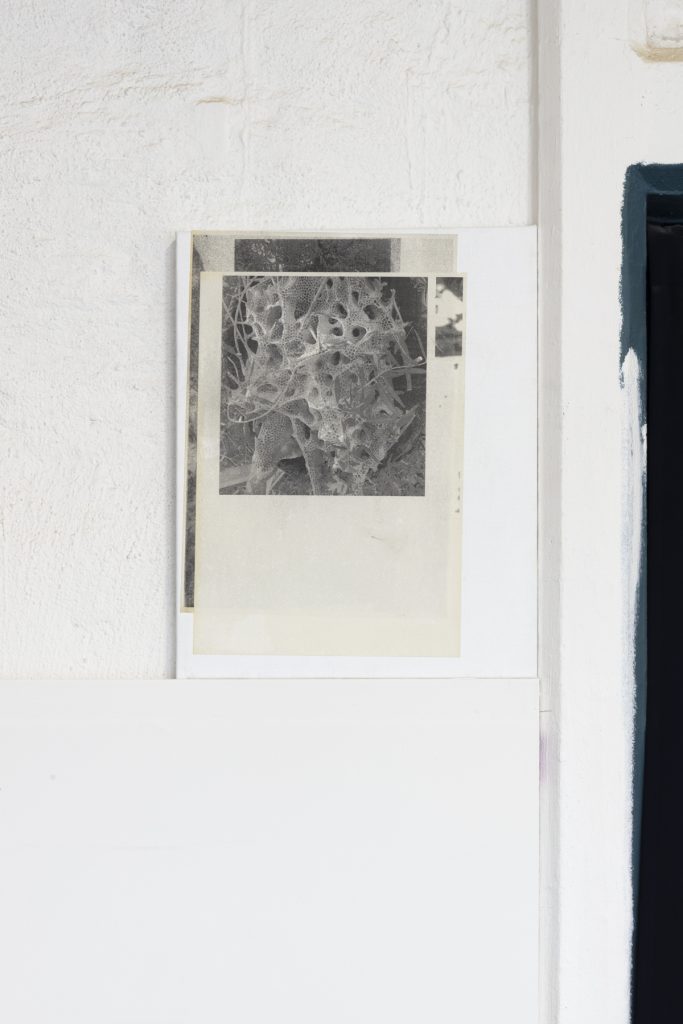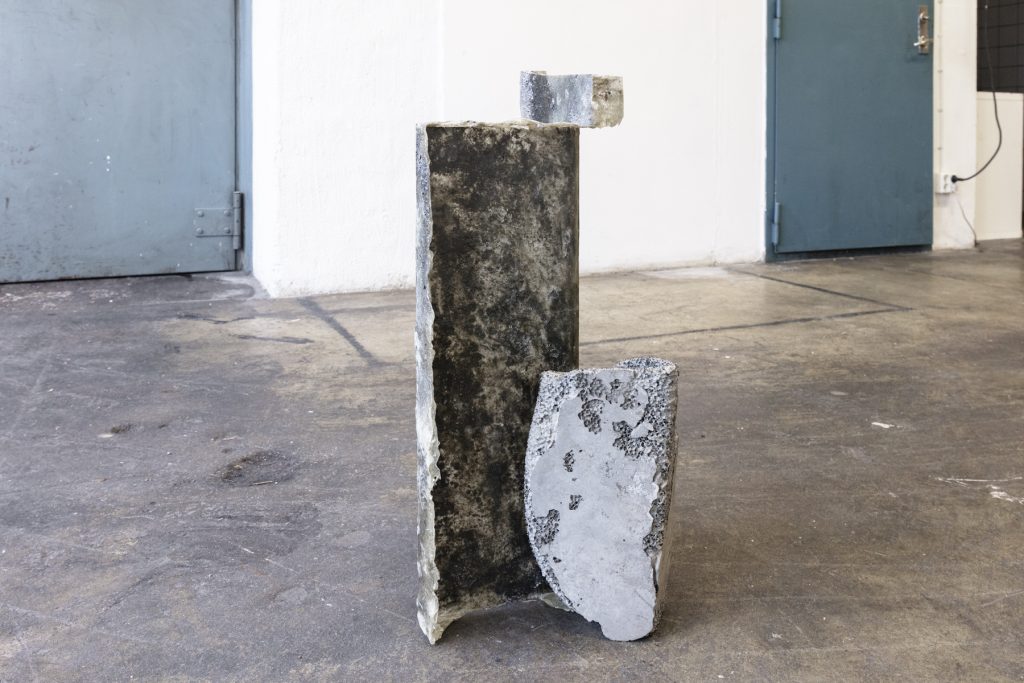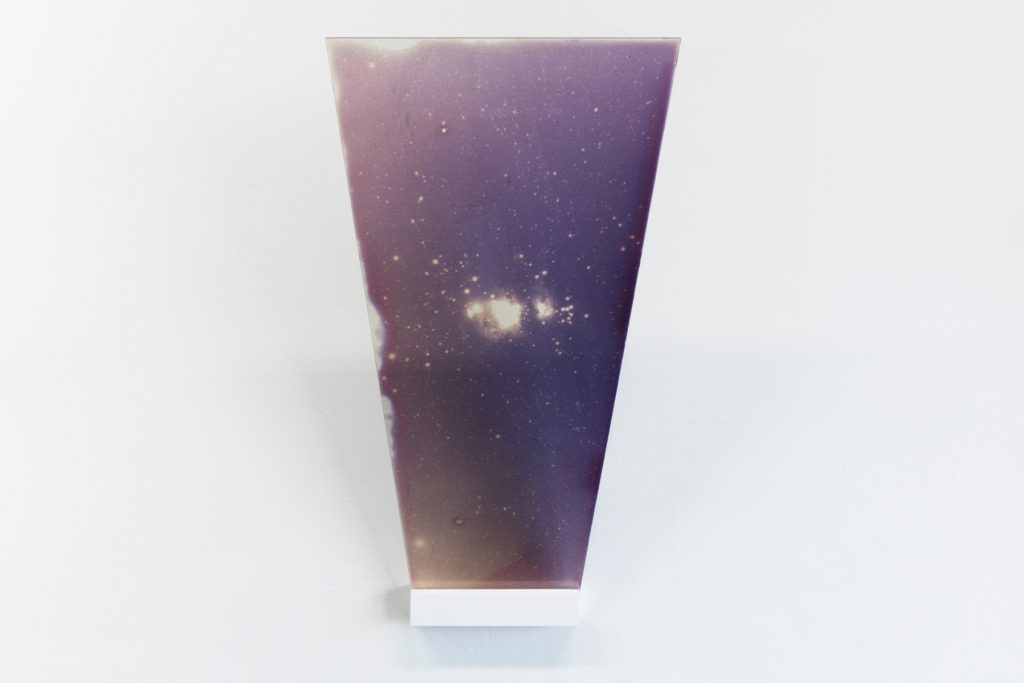
Ethereal Dwellings
Gonçalo Sena & Johan Österholm
14. – 16. February 2020
The dwellings of this exhibition disclose themselves as habitats and as reflections. The works are characterised by ephemeral processes typically found in sea, land or nightscapes, proceeding from and sometimes interrupted by human-made or biological mechanisms. Whether representational or bodies in their own right, they operate as modes of experiencing the world itself, created to be perceived and to elicit response and interpretation.
The biomorphically shaped Obsoleto e Simétrico finds its beginning as part of the ongoing series porous structures. The sculpture is hard to fully perceive although form and substance display a certain familiarity. Aliveness is staged, possibly it arrived from ashore, cut out from a larger sphere or left behind in a post-human flee.
Looking closer, the metaphysics of the materialities appear an aesthetic disillusion, mystically hybrid or simply, synthetic. Concrete, once patented “artificial stone”, now the most widely used material after water, is binding together whatever comes its way. Seen in the lining of Obsoleto e Simétrico, it asphyxiates copper wire.
An emphasis on process has created a somewhat pragmatic assemblage, both in its metaphorical and actual sense. Epoxy resin assembles a second part of the structure, inscribing multiplexed attributions into its solid body.
As it closes in, solidifies its constitutive parts, it unfolds a myriad of questions for far-reaching reflections.
The sculptural duo of strong, pseudo-biological binds can thus be seen as expressions of democratic and industrial processes, distinctly part of an increasingly domesticated nature.
Light pollution; anthropogenic light that disrupts the ambient light levels of the night. The pollutant is continously accelerating, spreading to most parts of the populated world, transforming human and non-human sensing perceptions of the night-scape. The intensity of the day-and-night cycle is becoming blurred before our eyes. Chances to watch luminous night skies are following suit. If anything, light pollution succeeds in painting a contemporary portrait of humanity enveloping itself and, under the circumstances, its microbial community,
into a luminous fog. In Untitled Lantern Pieces, sections of the night sky has been captured into light-sensitive glass plates recalling the shape and dimensions of the panes slotted into the frames of 19th century gas lanterns. Paradoxically alluring, the reflective space is shared between starkly stellar glittering and circumventing clutter in the atmosphere. Incidental, and always in transit, the various coloured plates can be seen as antonyms to homogeneous nocturnal ‘blandscapes’, the kind we see in most urban environments.
At the beginning of an increasingly industrialised era, beacons of light started to illuminate cities around metropolitan Europe. Formerly darkened walking paths, window displays and hidden corners now at the center stage, came to illustrate new civic focal points. Centuries later, when most worldly agents have put their and others surroundings in the spotlight, the slide projection Night Into Day show reversed tendencies. Smashing what once stole darkness, reclaiming spaces as occupants, birds seem to be heralding a return to the nocturnal, a recalibration of the relationship between light and dark. The stream following en-light-enment has been cut short, or switched off, if only for a brief moment.
Bees and wasps usually choose to hide their dwellings away from human eye-sight, positioning their nests in
corners and/or ceilings. As well, their complex constructions are always unique and ultra-ephemeral, an antithesis to machine-driven standardisation for solid grounds. Framed, move-able and assemblaged photocopies of abandoned bees and wasps-nests are found around the gallery space at Alta. The nests are free for anyone to download and print at the website of ATLAS Projectos. These analogly printed papercopies are aged by sunlight before they are glued onto canvases, inserting a biophysical process onto their otherwise mechanical reproduction scheme.
— Camilla Berggren Lundell
With kind support from Iaspis Cultural Exchange in Sweden.





























